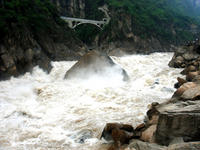You are in: Asia -> China -> Three Parallel River... , and traditional search or Image Gallery will yield results of this site only
Three Parallel Rivers of Yunnan Protected Areas
| Site number: | 1083 |
|
| Type of site: | Natural | |
| Date of Inscription: | 2003 | |
| Location: | Asia, China, Yunnan Province, Tibetan, Lijiang and Nujiang Lisu Autonomous Prefectures, | |
Up to 75 images are shown here. Click on each for more details or on Image Gallery for more images.
| Description: | The 1.7 million hectare site composed of eight geographical clusters of protected areas, within the boundaries of the Three Parallel Rivers National Park, is located in the mountainous north-west of Yunnan Province. The site holds sections of the upper reaches of three of the great rivers of Asia: the Yangtze (Jinsha), Mekong and Salween. The rivers flow roughly parallel, north to south, their routes running among steep gorges (in places-3,000 m deep) bordered by glaciated peaks (over 6,000 m in height). An epicentre of Chinese biodiversity; It is also one of the world’s wealthiest temperate regions in terms of biodiversity. --WHMNet paraphrase from the description at WHC Site, where additional information is available. | |
| Tiger Leaping Gorge is a canyon on the Yangtze River – locally called the Golden Sands River – located 60 km north of Lijiang City, Yunnan in southwestern China. Around 15 km in length, the gorge is located where the river passes between 5,596 metre Jade Dragon Snow Mountain (玉龙雪山; Yùlóngxuĕ Shān) and 5,396 m Haba Xueshan (哈巴山; Hābā Shān) in a series of rapids under steep 2000 metre cliffs. Legend says that in order to escape from a hunter, a tiger jumped across the river at the narrowest point (still 25 metres wide), hence the name. Tiger Leaping Gorge is a contender for the world's deepest river canyon, depending on the exact definition used. The inhabitants of the gorge are primarily the indigenous Naxi people, who live in a handful of small hamlets. Their primary subsistence comes from grain production and foreign hikers. The gorge is not considered navigable. In the early 1980s, four rafters attempted to go down the gorge and were never seen again. In 1986, the first known successful attempt to sail through the gorge was made by the first expedition to float down the entire length of the Yangtze, starting at the river's high source at the Gelandandong glacier lake. The area was officially opened to foreign tourists in 1993,but had attracted adventurous backpackers already in the 1980s. Officials plan to improve the existing trails and roads, bringing tour buses and more development. These plans arouse highly varied reactions among the local population, from strong opposition to strong support. Natural crystals are mined from areas in and surrounding the Tiger Leaping Gorge. --Wikipedia. Text is available under the Creative Commons Attribution-ShareAlike License. | ||
| Source: | http://whc.unesco.org/en/list/1083 | |
| Source2: | http://whc.unesco.org/en/list/1083/video | |
| Reference: | 1. UNESCO World Heritage Center, Site Page. | |

















